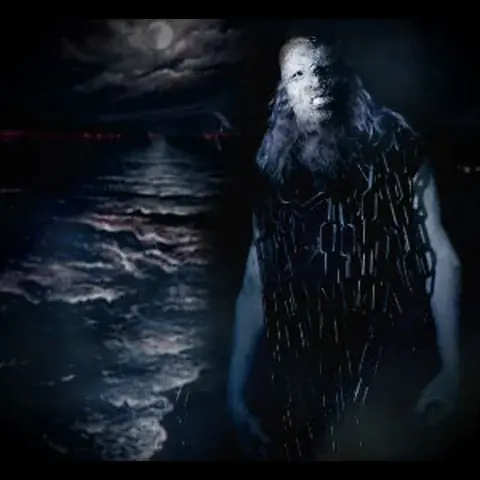In the shadowy corners of Gulf Arab folklore, a terrifying figure has haunted the dreams of children and the superstitions of elders alike.
Known as Abu al-Salasil, literally "The Father of Chains", this supernatural being is said to wander shorelines and alleyways, dragging iron chains behind him and unleashing terror upon those who cross his path.
He is not merely a myth to many; stories of encounters with him persist, passed from generation to generation across the United Arab Emirates, Oman, and even as far as southern Saudi Arabia.
This towering, dark-skinned entity is often described as wild-eyed and wrapped in heavy chains, either carrying them or bound by them. Some say his skin resembles charred leather, his claws sharp as blades, and his odor sickening. At night, he stalks coastal settlements, his chains scraping stone, creating a sound eerily reminiscent of crashing waves, an auditory illusion used by mothers to warn children: “Can’t you hear Abu al-Salasil coming ? ”
But who., or what, is Abu al-Salasil really ? Is he a restless spirit, a tortured soul, or a mere cautionary tale?
Origins of a Legend: Folklore or Reality ?
One popular tale suggests a grim origin rooted in human cruelty. Long ago, in the Emirate of Sharjah, a wealthy merchant is said to have owned a slave he kept shackled at all times. The slave was restrained with iron chains tied to a cannonball, preventing escape. After the merchant’s death, the abused man allegedly lost his mind and fled into the wilderness—mad, disfigured, and forever dragging the symbols of his torment. Locals began calling him “the chained servant” (al-‘abd al-muzanjal), and over time, myth swallowed reality.
Tales from the Coast
1- The Death of Rashid
In one Omani folktale, an audacious sailor named Rashid scoffs at warnings from his grandfather about Abu al-Salasil. One stormy night, as waves threaten to consume their village, Rashid ventures to sea against his grandfather’s pleas. Upon returning, drenched and shaken, he finds the monstrous figure awaiting him in a dark alley.
Chains clatter. Shadows flicker. Abu al-Salasil appears, eyes burning like coals. He pummels Rashid, binds him to a tree, and lashes him until dawn. When the villagers find Rashid’s broken body at sunrise, stained in blood and bound in iron, his grandfather weeps over him : “I warned you, my son. The wind brought demons with it.”
From that day on, sailors in the region refuse to set sail at night without divine protection.
2- A Mother's Warning Becomes Real
A woman from a coastal village in the UAE recalls trying to scare her child into napping:
"Go to sleep or Abu al-Salasil will come for you."
To her horror, the moment she finished the sentence, a roar and the clanging of chains erupted outside her thatched house. Terrified, she recited Quranic verses and prayed until the sound faded. She vowed never to invoke the chained spirit’s name again.
3- A Trickster Spirit ?
A different tale suggests that Abu al-Salasil is not indiscriminately violent. One storyteller explains that his cousin survived multiple encounters by simply outsmarting him. When the chained spirit blocked his path with a stretched leg, the cousin jumped over it. When it happened again, he crawled beneath it, and just like that, the entity vanished. “He only harms those who don’t understand his tricks,” the storyteller concludes.
4- The Sailor and the Iron Spirit
Another fisherman, walking to his boat past midnight, hears metallic scraping in the ruins near the coast. Mist envelops the area. From it, Abu al-Salasil materializes and lunges. As he pins the man to the ground, choking him, the sailor musters enough breath to recite the Ayat al-Kursi (a protective Quranic verse). Instantly, the entity vanishes. Though the man survives, strange gashes remain on his torso—marks like talons, deep and wide.
A Character of Culture and Caution
Abu al-Salasil is more than a ghost story. According to Emirati researcher Abdul Aziz al-Musallam, who compiled dozens of regional legends in his book Kharareef (“Folktales”), these mythical beings serve a social purpose. They act as guardians of morality, keeping children safe and preserving traditional boundaries through fear-based storytelling.
His book lists over 20 such characters, including Umm al-Subyan (the child-snatcher), Hamara al-Qaylah (the noon demoness), and Jinni al-Raqas (the dancing spirit). Each one symbolizes a danger,moral, physical, or social that the community must guard against.
A TV show by the same name, Kharareef, aired in 2002 and dramatized these myths, helping cement their place in popular consciousness.
Fear Born from the Sea ?
Some researchers suggest that Abu al-Salasil may have originated from a misinterpretation of natural sounds ,the crashing of waves against the shore, echoing like chains. Others believe he’s the ghost of a tortured soul. Whether metaphor or monster, Abu al-Salasil still lives on in the stories whispered at night.
Because sometimes, a sound in the dark is just the sea.
And sometimes, it’s not.







The story of the Chain-Wrapped Djinn haunting Gulf folklore is a fascinating glimpse into the region’s rich mythical traditions. Such legends reflect the deep cultural roots and storytelling heritage of the Gulf, sparking curiosity and imagination across generations. Just as folklore weaves intricate tales, embroidery digitizing services transform creative ideas into detailed stitched art. Both embody a fusion of tradition and modern expression—where one preserves ancient stories, the other revives them through visual design. In fact, such folklore can inspire unique embroidery pieces, bringing myth to life with digital precision and artistic craftsmanship. A truly magical blend of past and present!
ReplyDeleteTo her horror, the moment she finished the sentence, a roar and the clanging of chains erupted outside her thatched house. Terrified, she recited Quranic verses and prayed until the sound faded. She vowed never to invoke the chained spirit’s name again.
ReplyDeletecricut graphics
cricut templates
new year's cricut ideas
cricut logo ideas
cricut christmas fonts
critcuit